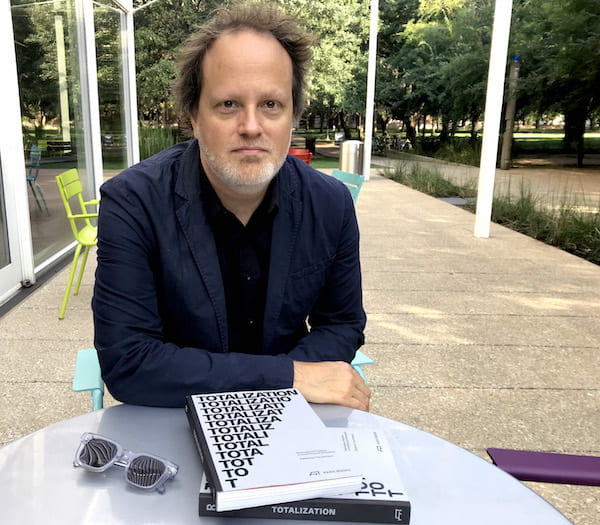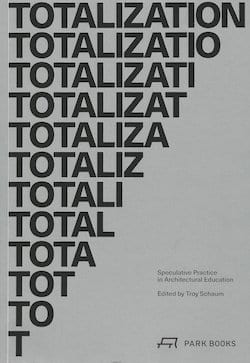Troy Schaum book analyzes innovative Totalization Studio’s past, present and future
Troy Schaum wants Rice Architecture students to leave the university with everything they need to not only work, but also lead.
To that end, the Rice associate professor and architect was an early proponent of teaching, along with the basics, the far-reaching implications of practice in a world that grows more complicated — and unpredictable — by the day.

Troy Schaum
That describes the school’s Totalization Studio which, for nearly a decade, has provided hundreds of students with the know-how to tackle the technical, collaborative, financial and political issues that come with every project.
Schaum, now the program’s director, felt it was time for a summing up. His book “Totalization,” published this month, gathers essays and examples from a host of Rice colleagues, alumni and collaborators in associated fields who offer the benefit of their experience to students both in Houston, at the Paris campus and at their own shops in New York and elsewhere.
Schaum brings to the table his own experience as an award-winning architect, discussing his projects through Schaum/Shieh, including his urban achievements at Houston’s White Oak Music Hall and the Transart House, a residence and private gallery.
“One of the important parts of Totalization studios is that almost all of our faculty are practitioners,” Schaum said. “Students don’t often get to see how our practices impact our research or teaching, so some of Totalization involves faculty presenting their practice work as part of the course, and having a conversation around that work.
“They get to see ideas that may seem theoretical or couched in academic terms are actually challenges we’re struggling with in the field,” he said. “Collapsing that space between the academy and the field is reflected in the book as well.”
The book anticipates the future of Totalization as part of changes at Rice Architecture, now led by John Casbarian, interim dean and Harry K. & Albert K. Smith professor, and with the anticipation of a new dean within the next year.
In advance of the book’s release and a Sept. 23 launch event in New York (with further events planned for Houston and Los Angeles), Schaum talked with Rice News about the program, the book and how Totalization has changed not only how architecture students learn but also how it has changed his own practice.
Q: How would you describe Totalization to, say, a chemist?
A: Totalization is an attempt to acknowledge the environment we expect our students to practice in — and lead — when they graduate from Rice.
Architecture, like a lot of fields, engages many disciplines, from building science to engineering to landscape to environmental specialists to politics. It’s always been at the center of this cauldron of specialized expertise. And architects are leaders who bring this expertise into agreement in service of a common project.
A hundred years ago, an architect with a few collaborators would conceive a project; the great projects of modernism were imagined that way. Today, project teams are tens and hundreds of people. Some schools of thought see that as a problem, or a loss for architecture. We see great potential in these collaborations and want to prepare our students to engage in them.
Our program is centered around individuals with very different expertise who operate in a high-caliber way in their own fields. We visit them in their offices and at their marquee projects, and they bring their expertise into studios at Rice.
Students execute traditional architectural design projects, but we want them to stretch, to ask the kinds of questions they might ask in practice in collaboration with these experts.
 We want them to know how to resolve complex problems around composite materials, or a new type of timber structure or an environmental system that can lead to a more sustainable solution — not something that’s not just tacked on, but integrated into the design. We know good design comes from synthesizing different kinds of expertise into a realizable whole. That is the demand that is placed on architects now.
We want them to know how to resolve complex problems around composite materials, or a new type of timber structure or an environmental system that can lead to a more sustainable solution — not something that’s not just tacked on, but integrated into the design. We know good design comes from synthesizing different kinds of expertise into a realizable whole. That is the demand that is placed on architects now.
So this book’s focus is twofold. First, it’s an attempt to explore the contemporary status of how architects collaborate and form teams with allied expertise, and second, it’s a reflection of the totalization program we built to explore these teams in design education.
Q: How does Totalization differ from the way you were taught?
A: When I was in school, if we traveled, it was to meet other architects. When we travel now, we meet experts and consultants in associated fields and see their projects.
Typically, early studios are about executing the basics. They might work with some rote problem in building science or design and rehearse to execute it well. Explore the fundamentals.
By the time our fifth-year B. Arch. and third-year master’s students reach the penultimate studio, we teach through actual research problems. We don’t just ask, “Where’s the center of this problem?” but “Where are the edges?”
Architecture is based in the problem of speculation. We’re always asked to speculate in territory where something’s never been done quite that way before. Students need to be comfortable in environments where they’re speculating with the support of and in collaboration with expertise that can help them do it responsibly.
Q: Why do other schools do things differently?
Every architect, every school and every firm does things a little differently. That’s the wonderful thing about being an architect and about being a small architecture school that can define its own way of teaching.
We have a lot of control at Rice, because of our size and status, to develop a program unique to the way we want to train architects – and it’s very successful. We have very high passing rates on architecture license exams.
The difference between our school and others is that we graduate a very small number of highly capable students every year and we help place them in the best firms in the world.
Q: How will the program change this year?
A: For 10 years now, almost since I’ve been at Rice, I’ve been taking students to New York to visit with experts and firms. In this next phase, we want to bring in more diverse expertise, more diverse consultants. We’re reaching out to local consultants who may be able to come to the studios more regularly and to a broader range of studio-specific consultants.
We’re also looking at opportunities to travel to other cities. A lot of these are because of the relationships we have with alumni in various places, so we’re looking at traveling to Los Angeles or other places on the West Coast.
Travel is the one moment where all the students in architecture are together. At the same time, each studio has individual research questions, so we want to give every studio more autonomy to get the consultants and do the travel they need.
Q: Who’s the audience for the book?
A: There are two. One would be a general audience, especially students, interested in problems of practice and the way architects engage with expertise. The other is anybody who’s interested in how practitioners and consultants collaborate.
Everyone who works in architectural design knows these collaborations exist. Some of them are very deep and last the course of their careers. One of our expert contributors, Nat Oppenheimer, brings up Mick Jagger and Keith Richards as an analogy.
But there’s not a lot of writing on the kind of collaborations we discuss, so academics and practicing architects will be interested in how consultants reflect on projects represented in the book and their experiences with students.
Q: How has Totalization informed your work as an architect?
Teaching is a powerful space for self-reflection and questioning, especially with the students we get at Rice. To constantly be tested by your students’ questions and expectations fortifies you.
In practice, our timescales sometimes become very short, and we think one to three years out. But our students are thinking, “What kind of a world am I going to be practicing in in 20 years?” So we have to train them to be leaders in a very different world.
Some of the questions we ask in Totalization, some of the research problems, are things that can’t be built now, but they’re questions our students will address when they’re in my place in their careers. We have to constantly immerse ourselves in that space, with issues of climate change, issues of housing scarcity, and other issues that are on their minds and are going to form their practice reality. These are things we have to confront.
Teaching in that way gives me a much more robust, 360-degree perspective about the challenges of the future. It’s a remarkable gift that doesn’t become apparent until you’re on the professor’s side of the education equation.

